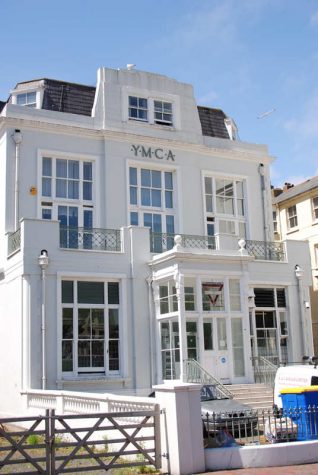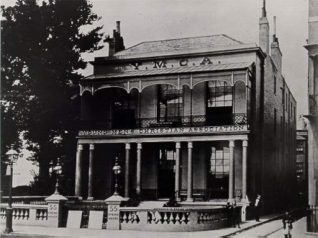Steine House, built in 1804


Please note that this text is an extract from a reference work written in 1990. As a result, some of the content may not reflect recent research, changes and events.
l) STEINE HOUSE: This house was built in 1804 by William Porden, the Prince of Wales’s architect, for Mrs Fitzherbert (see “George IV”) who lived here until her death in 1837. It originally had an Egyptian-style colonnade, but this was blown down in 1805 and the facade was rebuilt in Italian style with a trellised verandah and balcony supported by pillars. Later in the century however, the interior was substantially altered when the house was taken by the Civil and United Services Club, and in 1927 the building was entirely refaced and brought forward by the Young Men’s Christian Association which had taken over the building in 1884; a new floor of bedrooms was also added. Although it still has a verandah entrance, there have been so many alterations that the building is now listed for its historical associations rather than its architectural qualities, but an imitation bamboo iron staircase remains; Lord Barrymore once rode a horse up it for a bet. Fortunately a 1964 scheme to replace the house with an office block was defeated, and it is now used by the Y.M.C.A. as an emergency hostel for sixty-five people. {3,15,44,48,123}
Any numerical cross-references in the text above refer to resources in the Sources and Bibliography section of the Encyclopaedia of Brighton by Tim Carder.




Comments about this page
I lived in Steine house 1970-1972, prior to moving to 9 Bristol Gardens, Kemp Town, both of which are heritage listed, I note. I moved to Brighton to manage the testing laboratory of the (then) Sussex River Authority.
During the early 1960s, I worked at times in the snack bar which was available in the YMCA and more importantly, I played snooker almost every day in the front room on the first floor where three snooker tables were situated – we discovered that the cardboard end caps from the 3d rolls of horlicks tablets which were sold in the snack bar, worked in the time mechanism which were used to pay for the snooker tables so we could buy a tube of horlicks tablets for 3d and have a shillings worth of snooker time. – one of my jobs was to empty the money boxes, so then we just recycled the cardboard discs and no one knew – we were young and foolish I guess.
Add a comment about this page